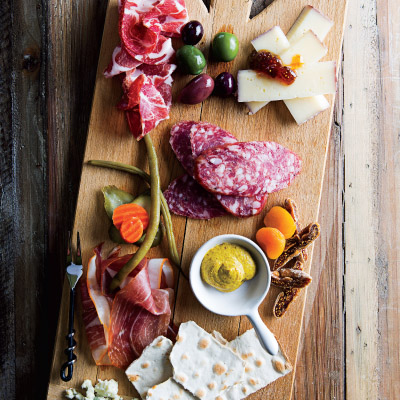
Building a Charcuterie Board
A charcuterie board doesn’t follow a recipe, but is instead a lesson in composition. Put together the perfect charcuterie plate with diverse textures and flavors using this easy cheat sheet.
Whole-Muscle CutsWhole-muscle cuts of meat are shaved into slices, usually paper-thin. Common examples are proscuitto, lomo de cerdo, a cured pork tenderloin often just referred to as lomo, and bresaola, beef tenderloin that’s been air-dried and salted.
Pickled VegetablesPickled vegetables complement the rich and salty flavors of meats and cheeses. Pickled items like red peppers, carrots, olives and red onions are a palate cleanser in between bites.
CheeseWhen pairing cheese with charcuterie, it is all about opposites. One element needs to contribute a sensation of tart, citrusy, mouth-watering brightness to cut the fat and protein of the other. Charcuterie board staple cheeses are soft creamy blue or Brie, a pungent washed-rind variety, a hard aged salty cheese, a tangy goat cheese, and something sharp
Dry-Cured MeatWhen using dry-cured meat such as salami or mortadella on a charcuterie board, mix it up with complementary and contrasting flavors. For example, a chorizo with a strong garlic flavor or a spicy sopressata should be balanced by something with a sweeter flavor profile, like mild and buttery saucisson sec.
Something SweetAdd a sweet component like an infused honey or jam to counterbalance the salty and fatty cheeses and meats. Dried fruit like apricots, cranberries or figs are also a nice complement to a charcuterie board.
MustardsMustards, made with a variety of sweet and savory herbs and spices, add complex flavor to a board. The tangy and spicy flavors also balance the richness of the cheeses and meats.
BreadAs a textural contrast, serve crusty bread, plain crackers, plain breadsticks or plain crostini. Mellow tasting items allow the flavor profile of the cheese and charcuterie to be at the forefront.
